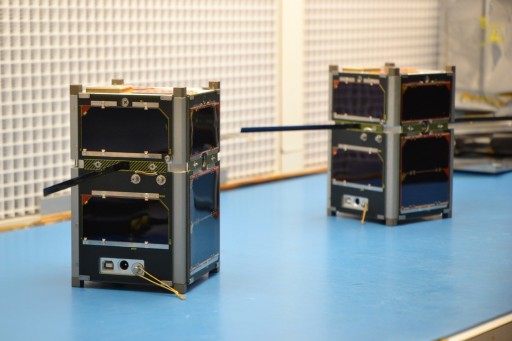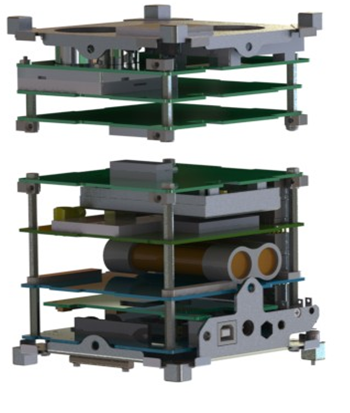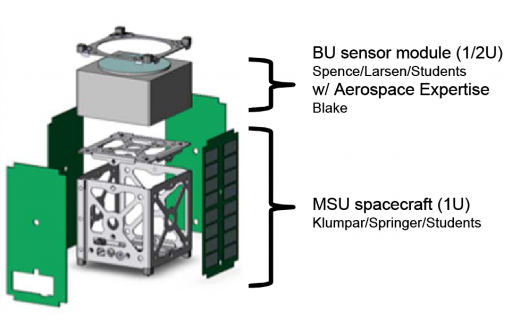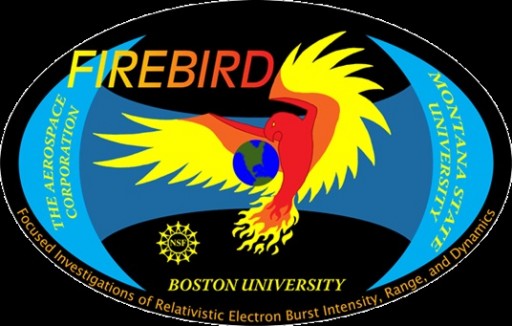FIREBIRD II-A & II-B

FIREBIRD II-A and FIREBIRD II-B represent the second pair of satellites in the Focused Investigations of Relativistic Electron Burst, Intensity, Range, and Dynamics mission. The first two satellites were launched as a secondary payload on an Atlas V rocket that delivered the classified NROL-39 to orbit in December 2013.
The small 1.5U CubeSats will study Space Weather, in particular electron microbursts in the Van Allen Belts. Relativistic electron microbursts are short (0.2s) durations of intense and localized electron precipitation from the Van Allen Belts onto the ionosphere, likely correlated to chorus waves generated in the near-equatorial region. Those events have been recorded by particle detectors on low-orbiting spacecraft and previous missions have quantified microbursts, but spatial scale and other important properties remain to be explored since single-spacecraft missions can not measure the spatial extent of one single microburst event. High energy microbursts are known to occur between 60 and 66 degrees latitude. Lower energy microbursts also occur in trains ranging from 10 seconds to several hours with a 0.5-second spacing in between bursts.


Microbursts are a significant loss mechanism for relativistic electrons, but are poorly understood. Insight into their specific properties is desired for better space weather models and radiation belt dynamics models. Simultaneous measurements from several sensors are needed to answer the fundamental question of the spatial scale size of microbursts, the energy dependence of an individual burst, and the quantification of electron loss due to microbursts on a global scale.
FIREBIRD will launch pairs of satellites into a low orbit for unique two-point focused observations to answer the fundamental questions on space weather implications caused by microbursts. FIREBIRD will further investigate the role of the whistler-mode chorus, by examining the microburst electron precipitation phenomenon attributed to chorus.
The two FIREBIRD Satellites will remain within 500 Kilometers of each other for 6 to 12 months, allowing a detailed characterization over the spatial scale regime from 10 to 500 km.
Each FIREBIRD satellite is 10 by 10 by 15 centimeters in size with a mass around two Kilograms using body-mounted solar cells for power generation and a magnetic attitude control system to keep the satellites in a predictable attitude required for measurement accuracy. The solar panels use Peak Power Tracking with electrical power being stored in 1.8Ah Li-Ion battery cells with two parallel strings to deliver a main bus voltage of 8.4 Volts that is converted to secondary voltages of 5 and 3.3 Volts.
Each satellite carries a 16-channel NovAtel GPS receiver to provide measurements of position and timing which are two important data points for the analysis of the timing and spatial extent of microbursts. The FIREBIRD satellite includes a PIC24 microcontroller, Flash RAM and an SD Card used to store acquired instrument and GPS data. The central controller is a 16-bit system running at 32MHz to reach 16 MIPS (Million Instructions Per Second). An internal 8Mhz oscillator is used for timing.
The stored instrument data is downlinked to the ground using a UHF terminal that operates at the 437MHz frequency for data downlink and command uplink. Data rates for downlink reach 9.6kbit/s using Gaussian Minimum Shift Keying modulation.

The spacecraft carry co-aligned Solid State Recorders that will detect electrons at energies of 30keV to up to 3MeV with a high time resolution of 100 milliseconds for Microburst Parameter Data using two energy channels.
Additionally, six energy channels provide event data from 200 to 1,050keV at a temporal resolution of 18.75ms. Six-second averages from two channels are used as context data and nominal data readout is completed by an Application-Specific Integrated Circuit. Precise GPS data acquired by each satellite allows the determination of the spatial size of microbursts.
NASA’s Van Allen Probes mission is also investigating the loss processes ongoing in the radiation belts using two spacecraft in highly elliptical orbits that fly through the radiation belts. The FIREBIRD satellites will provide complementing measurements of the electron environment below the Van Allen Probes’ orbit and determine the role of electron microbursts in the overall electron loss processes that are ongoing. FIREBIRD will also add two data points to the BARREL mission that is performed in conjunction with RBSP.
